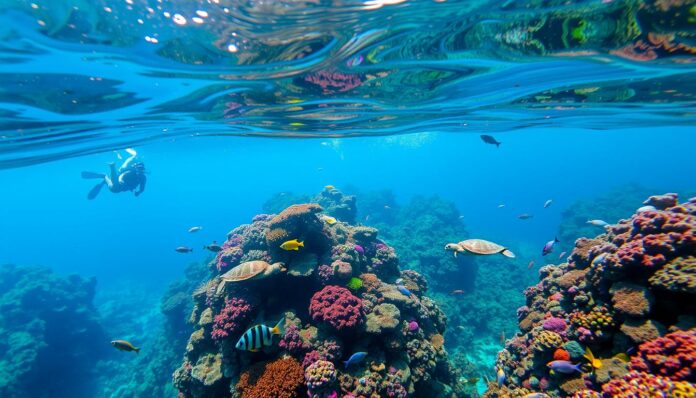| Best Time to Travel | October to May |
| What to Expect | Warm water, clear visibility, diverse marine life |
| Diving Conditions | Year-round, but best from October to May |
| Marine Life | Whale sharks, manta rays, turtles, sharks, dolphins, fish |
Have you ever wondered what secrets lie beneath the crystal-clear waters of Sri Lanka’s coastline? Scuba diving in Sri Lanka offers an unparalleled underwater exploration. It transforms ordinary travelers into extraordinary adventurers.
Imagine diving into a world where vibrant marine life dances around ancient coral reefs. Underwater landscapes tell stories millions of years old. With depths reaching up to 12 meters and water temperatures hovering around 28-29°C, Sri Lanka presents an inviting playground for divers of all skill levels.
From the west coast’s optimal diving conditions between November and early April to the east coast’s remarkable underwater terrain, each dive promises a unique journey. Professional PADI-certified instructors guide participants through an immersive experience. They ensure safety and create memories that last a lifetime.
Key Takeaways – Scuba Diving in Sri Lanka
- Accessible underwater exploration for ages 10 and up
- Professional PADI-certified diving instructors
- Optimal diving conditions on both west and east coasts
- Equipment rental included in diving packages
- Depths suitable for beginners and experienced divers
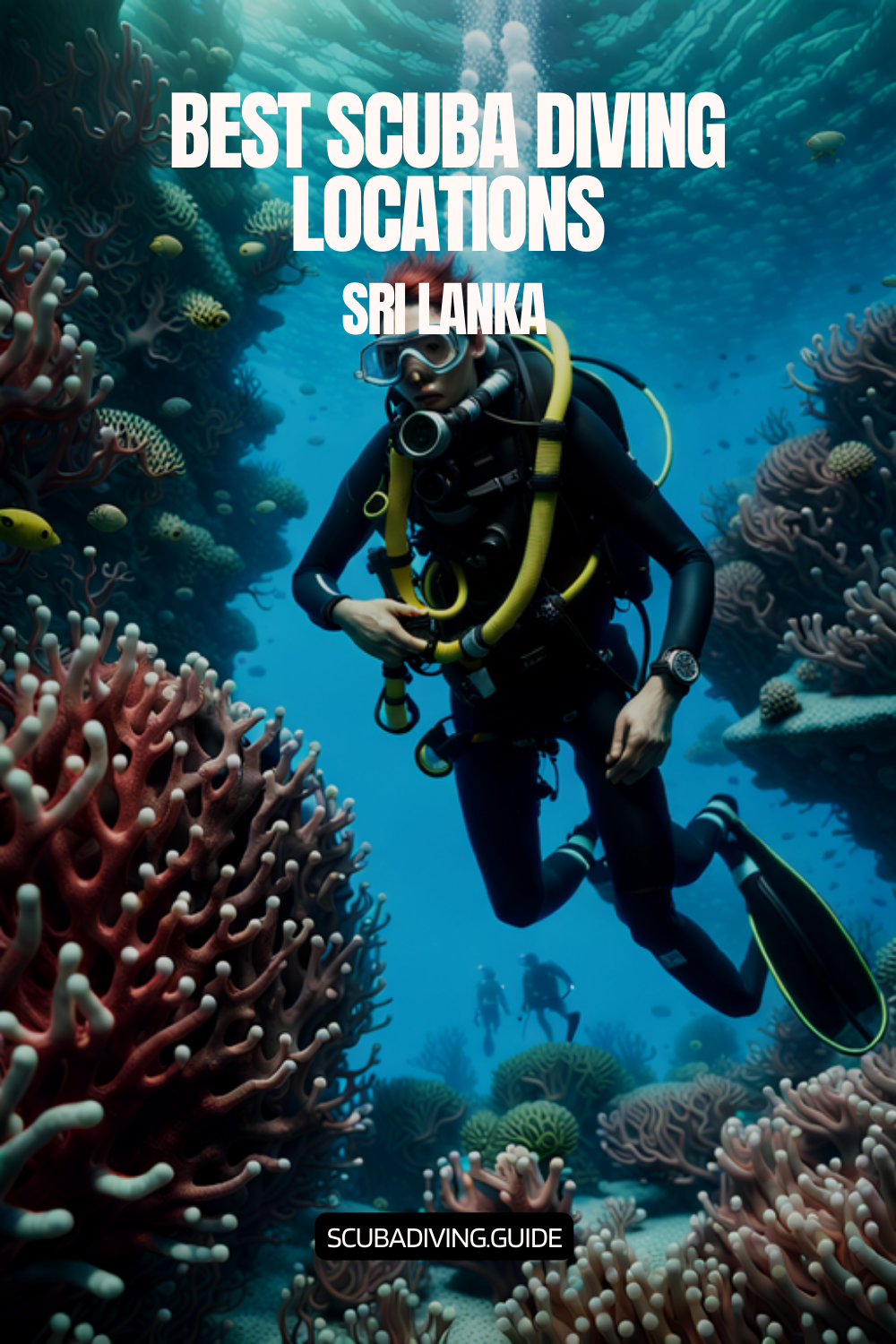
The Allure of Scuba Diving in Sri Lanka
Sri Lanka is a paradise for scuba diving, attracting divers from all over. Its stunning coastline stretches for about 1,340 kilometers. This offers a vast marine ecosystem to explore. The underwater landscapes of Sri Lanka are truly breathtaking.
Breathtaking Marine Biodiversity
The waters around Sri Lanka are full of marine life. Divers can see a world filled with different species. From colorful tropical fish to sea turtles, the Maldivian Sea Life enriches Sri Lanka’s waters.
- Manta rays frequent the waters near Pigeon Island National Park
- Whale sharks create magical underwater encounters
- Reef sharks inhabit the clear waters of Trincomalee
Vibrant Coral Reefs
Sri Lanka’s coral reefs are a colorful underwater world. They are home to many marine creatures and offer divers a unique experience. Dive sites in Hikkaduwa and Unawatuna are great for all levels of divers.
| Dive Location | Water Temperature | Visibility |
|---|---|---|
| West Coast | 28-29°C | 5-10 meters |
| Trincomalee | 27-30°C | 10-15 meters |
Unique Dive Sites
Sri Lanka has amazing underwater landscapes for diving. The limestone formations in Kirinda stretch for about 40 kilometers. Kalpitiya is also exciting, with its soft coral formations and diverse marine life.
“Every dive in Sri Lanka is a journey of discovery, revealing the hidden wonders of the ocean.”
Divers can explore wreck sites like the SS Conch at 33 meters or the British Sergeant wreck in Batticaloa. These sites offer thrilling dives and are important for marine species.
Best Locations for Scuba Diving
Sri Lanka has an amazing 1,600 km of coastline. It’s a paradise for underwater explorers. With diverse marine environments and many Shipwreck Diving Sites, it offers unique Snorkeling Adventures for all.
Diving in Sri Lanka shows incredible underwater landscapes. It attracts marine explorers from all over. The country’s location offers special opportunities for underwater discovery.
Hikkaduwa – A Diver’s Paradise
Hikkaduwa is a top diving spot with vibrant coral gardens. Divers can see:
- Colorful coral reef ecosystems
- Diverse marine life habitats
- Shallow and deep diving opportunities
Trincomalee – Wreck Diving Haven
Trincomalee is known for its Shipwreck Diving Sites with historical treasures. Highlights include:
- The shallow reef stretching 700 meters behind the hospital
- Fascinating shipwreck exploration
- Depths ranging from 20 to 33 meters
Unawatuna – Rainbow of Marine Life
Unawatuna offers magical Snorkeling Adventures with rich marine life. Divers can expect:
- Spectacular underwater visibility
- Encounters with diverse marine species
- Pristine reef environments
“Each dive in Sri Lanka is a journey through an underwater wonderland” – Experienced Diving Instructor
Water temperatures are between 80-86°F all year. This makes Sri Lanka perfect for diving any time. The varied dive sites are great for both beginners and advanced divers, ensuring a memorable underwater experience.
Ideal Seasons for Diving
Planning your underwater adventure in Sri Lanka means knowing the best times to dive. The island’s location gives different diving spots all year round.
Sri Lanka has two main diving seasons. Each season offers something special for those who love the sea and want to explore it sustainably.
West and South Coast Diving Season
The west and south coasts are best for diving from November to early April. During this time, the water is clear, making it perfect for diving.
- Peak diving months: November through April
- Average water temperature: 27-30 degrees Celsius
- Typical underwater visibility: 5-15 meters
East Coast Diving Opportunities
The east coast is open for diving from March to October. It’s great for those who want to explore more of the underwater world.
| Location | Diving Season | Visibility Range | Typical Depth |
|---|---|---|---|
| Unawatuna (South) | 15 Oct – 10 Apr | 5-15 meters | Up to 32 meters |
| Nilaveli (East) | 15 Mar – 30 Oct | 5-20 meters | 10-18 meters |
Monsoon Season Considerations
Monsoon seasons can make diving tricky, but they don’t stop it completely. The bad weather usually lasts only 1-2 hours. Most days have 8 hours of sunshine.
“Every season in Sri Lanka offers a unique underwater perspective for divers willing to adapt and explore.” – Local Diving Expert
Before diving, check the local diving center’s schedule and the weather forecast. This helps plan your underwater adventure well.
Essential Scuba Diving Gear
When diving in Sri Lanka, picking the right gear is key. PADI Dive Centers suggest specific equipment for a safe and fun dive. They also support sustainable tourism.
Choosing the Right Equipment
Choosing the right scuba gear is vital for a great dive. Good gear means comfort, safety, and better performance.
- Mask: Crucial for clear underwater vision
- Fins: Provides efficient underwater movement
- Wetsuit: Protects against water temperature and marine environment
- Regulator: Enables breathing underwater
- Buoyancy Compensator Device (BCD): Controls underwater positioning
Renting vs. Buying Gear
Divers in Sri Lanka have two main choices for gear.
| Renting | Buying |
|---|---|
| Cost-effective for occasional divers | Long-term investment for frequent divers |
| No maintenance required | Personalized equipment fit |
| Perfect for travelers | Consistent gear familiarity |
“The right gear transforms your diving experience from good to extraordinary.” – Professional Dive Instructor
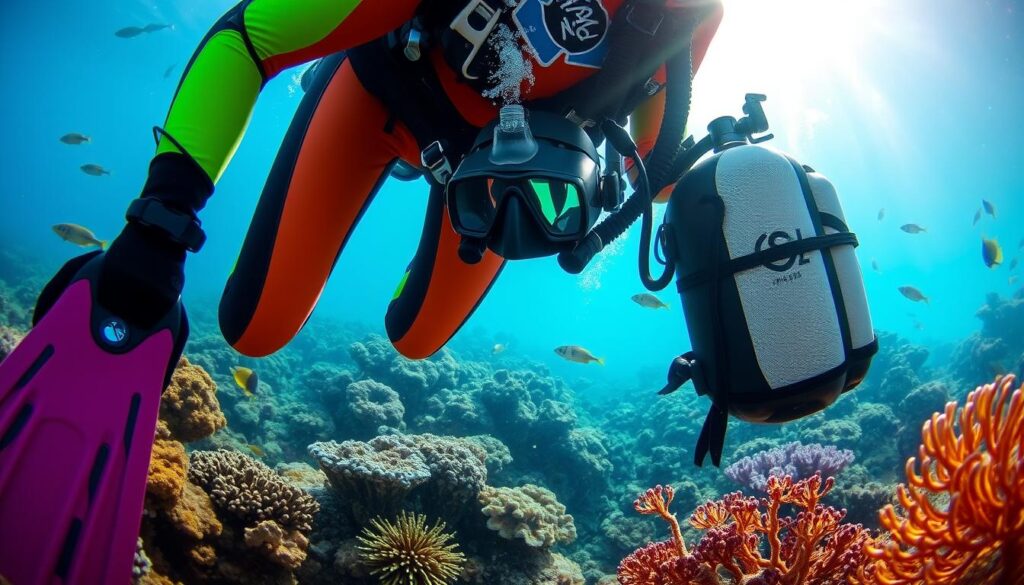
PADI Dive Centers in Sri Lanka offer top-notch rental gear. This lets travelers enjoy diving without a big investment. Beginners can rent, while experienced divers might buy their own.
Consider the gear’s condition, fit, and the local diving scene. Most centers help pick the best gear for your level and goals.
Finding Certified Diving Schools
Starting a scuba diving adventure in Sri Lanka means picking the right school. Certified PADI Dive Centers are key for safe and fun underwater trips. They help travelers explore the sea.
The diving industry in Sri Lanka focuses on sustainable tourism. Top diving schools offer great training and experiences. They teach more than just diving, they help understand the sea.
Why Certification Matters
International certifications like PADI mean top training and safety. When picking a diving school, look at these important points:
- Professional instructor qualifications
- Safety record and reputation
- Range of course offerings
- Student-to-instructor ratio
Top-Rated Diving Schools in Sri Lanka
Several diving schools in Sri Lanka are truly exceptional:
- Divinguru®: A PADI 5 Star IDC Dive Resort with over 20 years of experience
- Unawatuna Diving Centre: Operational for 23 years
- Trincomalee Diving Academy: Known for coastal diving
“Choosing the right diving school turns your underwater journey into an unforgettable adventure.” – Professional Diving Instructor
These PADI Dive Centers have programs for all levels. From beginner dives to advanced certifications. They keep groups small, with 5 divers per instructor, for better safety and attention.
Scuba Diving for Beginners
Diving into Sri Lanka’s underwater world is thrilling for newbies. Scuba Diving in Sri Lanka offers great chances for beginners. They can explore marine wonders through introductory programs at PADI Dive Centers.
Your First Underwater Adventure
New divers have many exciting entry-level courses to choose from. These courses are designed for different skill levels and ages. The most popular options include:
- PADI Discover Scuba Diving (DSD) for ages 10+
- Bubblemaker program for children aged 8-10
- PADI Scuba Diver certification
- PADI Open Water Diver course
What Beginners Can Expect
First-time divers will go through a structured learning process. This process ensures safety and builds confidence. Here’s what you can expect:
| Course | Duration | Price | Depth Limit |
|---|---|---|---|
| PADI Discover Scuba Diving | 1 day | $100 | Shallow waters |
| PADI Scuba Diver | 2.5 days | $270 | 12 meters |
| PADI Open Water Diver | 4 days | $440 | 18 meters |
“Learning to dive is about discovering a whole new world beneath the waves!” – Local PADI Instructor
PADI Dive Centers in Sri Lanka offer thorough training. This includes theoretical lessons, pool practice, and supervised open water dives. Experienced instructors guide beginners through each step, ensuring a safe and memorable first diving experience.
If you’re feeling nervous, don’t worry. Instructors focus on safety and comfort. They’ll help you overcome initial anxieties and develop confidence in the water. Your first dive is just the beginning of an incredible underwater journey!
Advanced Diving Opportunities
Sri Lanka is a hotspot for Underwater Exploration, perfect for those who love diving. It’s not just for beginners. Experienced divers can find amazing Shipwreck Diving Sites that test their skills and offer unique underwater experiences.
For those who want to dive deep, Sri Lanka’s coastline is full of challenges. It has many diving spots for those who have been diving for a while.
Wreck Diving Adventures
Wreck diving is a top choice for diving in Sri Lanka. It offers deep dives into history for technical divers:
- British Sergeant wreck in Batticaloa (24 meters deep)
- HMS Hermes wreck (44 meters deep)
- Galle Shipwreck in Unawatuna (18-30 meters deep)
| Wreck Site | Depth Range | Recommended Certification |
|---|---|---|
| British Sergeant | 24 meters | Advanced Open Water |
| HMS Hermes | 44 meters | Technical Diving |
| Galle Shipwreck | 18-30 meters | Advanced Open Water |
Night Diving Experiences
Night diving turns the ocean into a magical world. It lets divers see nocturnal marine life and the ocean’s beauty at night.
“Night diving reveals a completely different underwater world, where darkness brings marine creatures to life in unexpected ways.” – Professional Diving Instructor
These dives need special training, the right gear, and respect for the sea. Divers should get the right certifications before diving into these adventures.
Marine Conservation Efforts
Sri Lanka’s underwater world is a vital ecosystem that needs protection. Sustainable tourism helps keep the marine environments safe. This is key for the Sri Lankan Coral Reefs and their amazing biodiversity.
In Sri Lanka, efforts to protect underwater habitats and marine life are growing. Many initiatives aim to tackle environmental issues and encourage diving that’s good for the ocean.
Importance of Sustainable Diving
Sustainable diving is more than just enjoying the sea. It means getting involved in conservation. Divers can help by:
- Practicing responsible underwater photography
- Maintaining proper buoyancy control
- Following the “look but don’t touch” principle
- Using reef-safe sunscreen
Organizations to Support
Many organizations are working hard to protect marine ecosystems in Sri Lanka. Their efforts are vital for keeping the sea safe and supporting sustainable tourism.
| Organization | Conservation Focus | Key Achievements |
|---|---|---|
| Cleaner Seabeds for Sri Lanka | Underwater Litter Removal | 2,300+ volunteers, 1,714 kg of nurdles removed |
| Nurdle Free Lanka | Plastic Pollution Control | Advanced trommel technology deployment |
| Local Dive Centers | Coral Reef Restoration | Active participation in marine habitat protection |
“Every dive is an opportunity to become a guardian of our marine ecosystems.” – Marine Conservation Expert
By supporting these organizations and diving responsibly, visitors can help protect Sri Lanka’s underwater wonders for the future.
Local Cuisine for Divers
After a thrilling day of Scuba Diving in Sri Lanka, food lovers have a lot to explore. The island’s food scene is a mix of flavors that match the underwater adventures. It’s a key part of sustainable tourism.
Must-Try Seafood Delicacies
The coast of Sri Lanka is full of fresh seafood that divers can’t resist. The local food tradition celebrates the sea with amazing dishes. These dishes show the island’s commitment to sustainable fishing.
- Fish Ambul Thiyal: A tangy, dry-prepared fish dish with unique sour flavors
- Jumbo Prawns grilled to perfection
- Crab Curry with rich, spicy coconut sauce
- Lobster prepared in traditional Sri Lankan style
Refreshing Beverages for Rehydration
After diving, divers can refresh with local drinks. These drinks capture the island’s tropical vibe.
| Beverage | Description |
|---|---|
| King Coconut Water | Natural electrolyte-rich drink perfect for post-dive hydration |
| Fresh Fruit Juices | Mango, papaya, and passion fruit options available |
| Lime Juice | Refreshing local favorite with mint and sugar |
“The true essence of Sri Lankan cuisine lies not just in its flavors, but in its connection to the land and sea.” – Local Chef Recommendation
By trying local foods, divers help sustainable tourism and learn about Sri Lanka’s culture. Every meal supports local businesses and celebrates the island’s food variety.
Cultural Aspects to Consider
Diving in Sri Lanka is more than just exploring the sea. It’s about respecting local culture, making your trip truly special. By understanding the culture, you can have positive interactions with the people.
Sri Lankan culture is all about respect and tradition. To dive well, you need to be culturally aware. It’s not just about knowing how to dive.
Local Customs and Social Etiquette
- Remove shoes before entering homes or religious sites
- Dress modestly, specially near temples and rural areas
- Use right hand for eating and greeting
- Learn basic Sinhala or Tamil greetings
Best Practices for Respectful Diving
When diving, it’s important to protect the sea and respect local traditions. Divers should:
- Respect sacred underwater sites
- Avoid disturbing local fishing practices
- Minimize environmental impact
- Support local marine conservation efforts
“Diving is not just about discovering marine life, but understanding and preserving the cultural ecosystem.” – Local Marine Conservationist
| Cultural Consideration | Recommended Action |
|---|---|
| Religious Sites | Seek permission, dress appropriately |
| Marine Interactions | Respect local fishing traditions |
| Environmental Impact | Follow sustainable diving guidelines |
Embracing local culture makes your diving trip more meaningful. It creates lasting connections that go beyond the usual tourist experience.
Safety Precautions While Diving
Scuba diving in Sri Lanka is amazing, but safety comes first. Divers must know important safety rules to have a safe and fun dive.
Understanding Dive Tables and Limits
Dive tables help manage time underwater and avoid risks. PADI Dive Centers stress these key safety tips:
- Maximum dive depth in Sri Lanka: 30 meters
- Mandatory safety stop: 3 minutes at 5 meters depth
- Minimum tank pressure for safety stop: 50 bar
- Minimum rest time between dives: 2 hours
Recognizing Decompression Sickness
Knowing the signs of decompression sickness is vital for Sri Lanka’s divers. Spotting it early can stop serious health issues.
| Symptom Category | Specific Signs | Recommended Action |
|---|---|---|
| Neurological | Tingling, numbness, weakness | Seek immediate medical attention |
| Skin | Rash, marbled skin texture | Stop diving, consult professional |
| Respiratory | Chest pain, difficulty breathing | Administer oxygen, call emergency services |
“Safety in diving is not about being fearless, but about being prepared and knowledgeable.” – Diving Safety Expert
Scuba diving in Sri Lanka needs divers to be careful and ready. Always listen to PADI Dive Centers, get regular health checks, and never dive alone.
- Minimum age for diving: 18 years
- Annual medical examination required
- No diving within 8 hours of alcohol consumption
- Maintain proper hydration and rest
By knowing these safety tips, divers can safely explore Sri Lanka’s stunning underwater world.
Scuba Diving Packages and Pricing
Planning your underwater adventure in Sri Lanka needs careful budgeting. Scuba Diving in Sri Lanka has packages for all levels. Knowing the prices is key for a great diving experience.
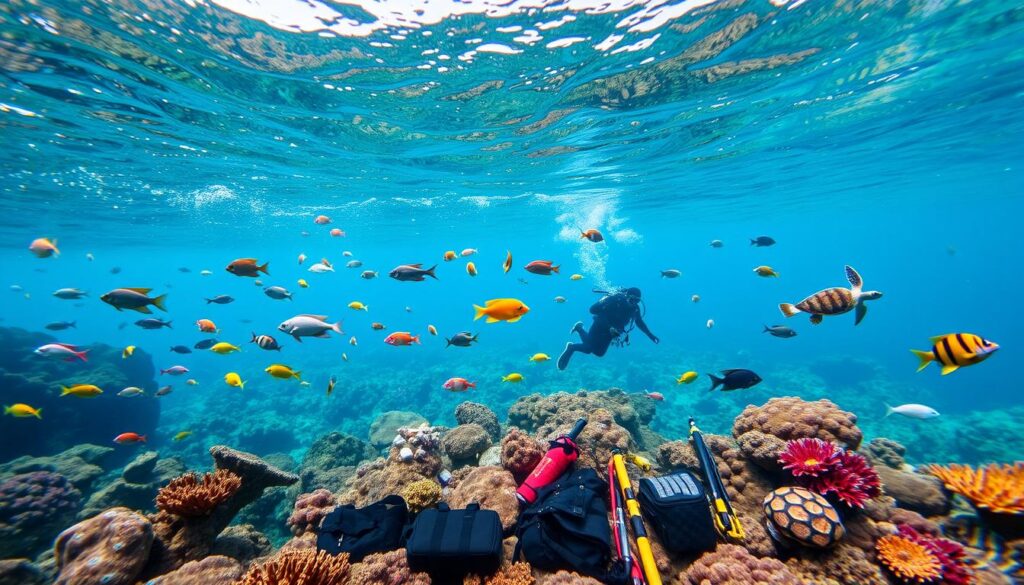
Budgeting for Your Diving Adventure
PADI Dive Centers in Sri Lanka have clear pricing. Here’s what you can expect to pay:
- Single Tank Boat Dive with own equipment: 45 €
- Single Tank Boat Dive with rental equipment: 50 €
- Two Tank Boat Dive with own equipment: 80 €
- Two Tank Boat Dive with rental equipment: 90 €
Diving Package Options
For more diving, multi-dive packages are a great deal. Scuba Diving in Sri Lanka has flexible options:
| Package Type | Own Equipment | Rental Equipment |
|---|---|---|
| 2 Boat Dives | 80 € | 90 € |
| 4 Boat Dives | 150 € | 170 € |
| 6 Boat Dives | 220 € | 250 € |
“The best investment in diving is not just the price, but the experience you’ll gain underwater.”
Additional Considerations
Remember these extra costs when planning:
- Equipment rental (BCD, regulators, etc.)
- Certification fees
- Transportation to dive sites
- Additional adventure dives
Pro tip: PADI Dive Centers give 10% off for online bookings 48 hours in advance. Always look for current deals to save more!
Testimonials from Divers
Diving fans from all over the world have shared amazing stories about Sri Lanka’s underwater world. With a 100% traveler recommendation rate for PADI Scuba Diver Courses, it’s a top spot for underwater adventures. People love the expert teaching and the incredible sea life they meet.
Many divers talk about their amazing whale shark encounters. They say it’s unforgettable at dive sites near Trincomalee, where the sea is full of life. These beginner-friendly dives welcome up to 15 people, with a 100% positive review rate. Everyone praises the thorough training, which includes pool practice and expert advice.
Real Experiences from Recent Visitors
Divers love the safety and quality of the equipment. Many say the dive team is always ready to help and keeps the gear in top shape. Whether you’re new or experienced, the training is well-structured. Plus, the early morning tours start at 8:00 AM, giving you the best time to dive.
Tips from Fellow Divers
Experienced divers say you should be moderately fit and know about any health issues. They advise booking early because tours are limited to 8 people. Prices range from $114 to $215 per person, making it a unique and unforgettable dive in Sri Lanka’s beautiful seas.
Sri Lanka Recommended Scuba Diving Itinerary
Planning a scuba diving trip to Sri Lanka? Here’s a recommended itinerary that will allow you to explore some of the best dive sites and experience the diverse underwater world this beautiful island nation has to offer.
Day 1: Arrival in Colombo
Arrive at Bandaranaike International Airport in Colombo, the capital city of Sri Lanka. Take some time to relax and adjust to the local time. Explore the city’s cultural attractions and sample the delicious local cuisine.
Day 2-3: Dive in Hikkaduwa
Travel south to Hikkaduwa, a popular diving destination known for its vibrant coral reefs and shipwrecks. Spend two days diving in the Marine National Park, exploring the underwater world teeming with colorful fish, turtles, and fascinating marine creatures.
Day 4-6: Trincomalee and Pigeon Island
Head to the northeastern coast and discover the pristine diving sites around Trincomalee. Dive at Pigeon Island, a protected marine reserve famous for its coral gardens, schools of fish, and encounters with turtles and reef sharks. Take time to relax on the beautiful beaches and enjoy the tranquil surroundings.
Day 7-9: Explore Nilaveli
Continue your journey along the east coast to Nilaveli, a tranquil coastal town renowned for its stunning beaches and exceptional diving opportunities. Dive in the clear waters, explore the coral reefs, and keep an eye out for whale sharks and manta rays. Enjoy the serenity of this picturesque location.
Day 10-12: Batticaloa and Great Basses Reef
Travel south to Batticaloa, a city with a rich cultural heritage and incredible diving possibilities. Dive at the Great Basses Reef, an underwater paradise featuring vibrant coral formations, caves, and a myriad of marine life. Immerse yourself in the beauty of this unique diving location.
Day 13-14: Kalpitiya and Bar Reef Marine Sanctuary
Make your way to Kalpitiya, a coastal town on the northwest coast of Sri Lanka. Dive at the Bar Reef Marine Sanctuary, one of the largest coral reefs in the country. Encounter dolphins, whale sharks, and a wide variety of colorful reef fish. Enjoy the picturesque sunsets and the relaxed beach vibe.
Day 15-16: Mirissa and Whale Watching
Head south to Mirissa, a renowned whale-watching destination. Take a break from diving and embark on a thrilling whale-watching excursion. Spot majestic blue whales, playful dolphins, and other marine mammals in their natural habitat. Enjoy the coastal charm of Mirissa and relax on its beautiful beaches.
Day 17-18: Unawatuna and Rock Formations
Travel west to Unawatuna, a coastal town known for its scenic beauty and excellent diving sites. Dive among fascinating underwater rock formations, explore vibrant coral gardens, and encounter a variety of marine species. Take time to unwind on the palm-fringed beaches and indulge in the local cuisine.
Day 19-20: Tangalle and Offshore Reefs
Continue your journey to Tangalle, a peaceful coastal town blessed with beautiful beaches and a relaxed atmosphere. Dive at offshore reefs known for their rich marine biodiversity. Explore the underwater caves, encounter fascinating marine creatures, and enjoy the tranquility of this secluded diving location.
Day 21: Departure from Colombo
Return to Colombo for your departure. Take time to explore the city’s vibrant markets, visit cultural sites, and reflect on the incredible diving adventures you’ve experienced in Sri Lanka.
This itinerary provides a glimpse into the diverse scuba diving opportunities available in Sri Lanka. However, it’s important to note that weather conditions, seasonal variations, and personal preferences may require adjustments to the itinerary. Consult with local dive operators and plan your trip accordingly to make the most of your scuba diving adventure in Sri Lanka.
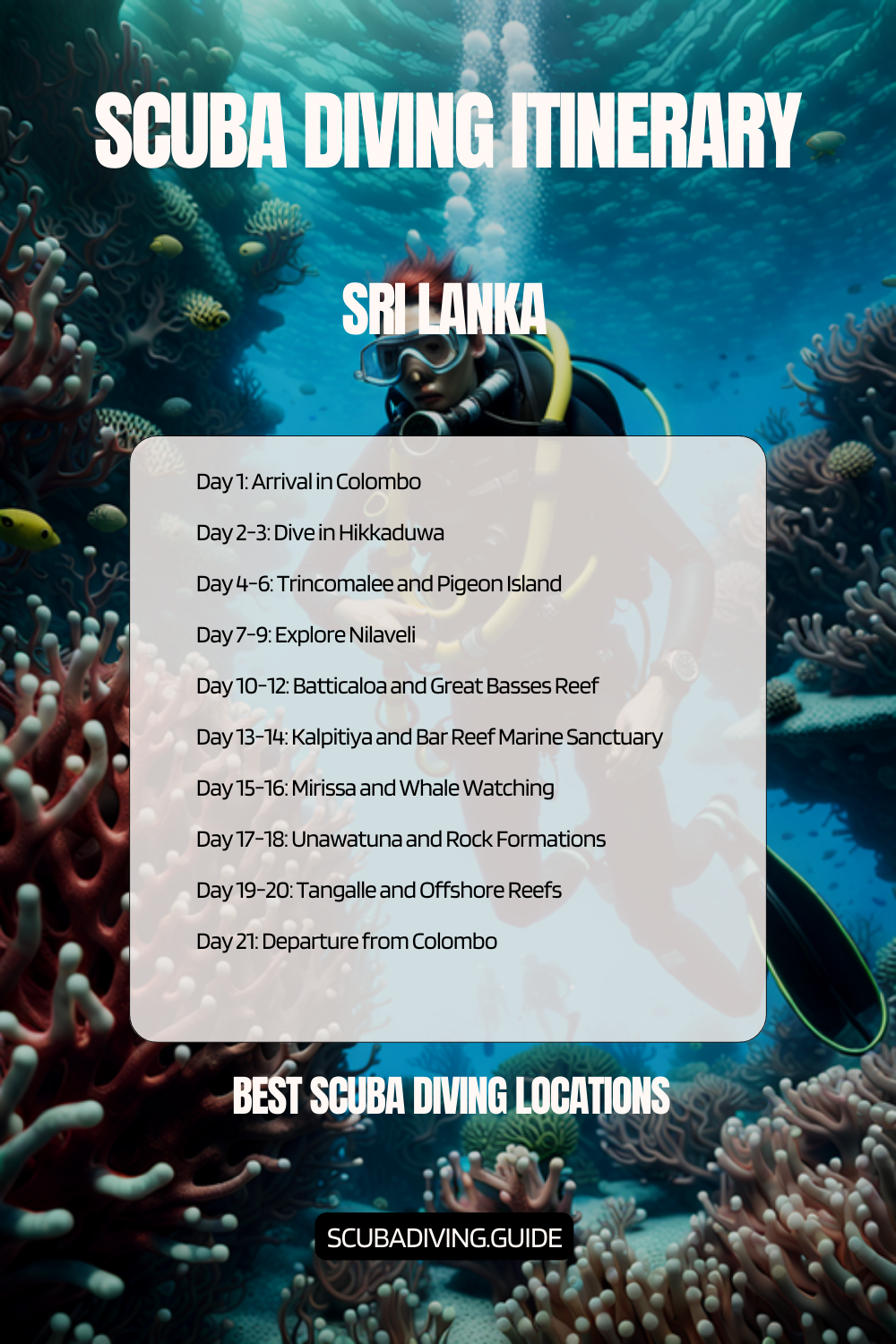
Other Countries to Consider
FAQ – Scuba Diving in Sri Lanka
What are the best seasons for scuba diving in Sri Lanka?
The best diving seasons vary by coast. For the west and south coasts, dive from November to April. The east coast is great from March to October, with clear water and lots of marine life.
Do I need prior diving experience to dive in Sri Lanka?
No, you don’t need experience. Sri Lanka has diving for all levels. PADI Dive Centers offer courses for beginners, and experienced instructors guide first-timers.
What marine life can I expect to see while diving in Sri Lanka?
Sri Lanka’s waters are full of life. You’ll see tropical fish, sea turtles, and coral reefs. Places like Hikkaduwa and Trincomalee have unique marine life.
Are there any specialized diving experiences in Sri Lanka?
Yes! You can dive wrecks, go night diving, or explore underwater limestone formations. Each experience is unique and exciting.
What certifications should I look for in a diving school?
Look for PADI or SSI certifications. They mean the school follows high safety standards and offers quality training. Good dive centers also care about marine conservation.
How expensive is scuba diving in Sri Lanka?
Prices vary based on your experience and where you dive. Introductory dives are affordable. Packages and combo activities can save you money.
What safety precautions should I take while diving?
Always follow safety rules and dive with a buddy. Know your limits and listen to your instructor. This ensures a safe dive.
Can I contribute to marine conservation while diving?
Yes! Dive sustainably by avoiding touching marine life and supporting eco-friendly centers. Many organizations need divers’ help in protecting coral reefs.
What equipment do I need for diving in Sri Lanka?
You’ll need a wetsuit, mask, fins, and regulator. Most dive centers offer rentals. Make sure your gear fits well and is comfortable.
Are there diving opportunities for children?
Yes! Dive centers offer programs for kids, like PADI’s Bubble Maker course. These programs introduce young divers to the underwater world safely.
